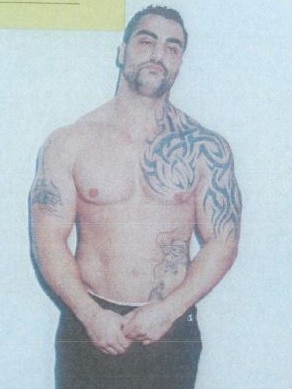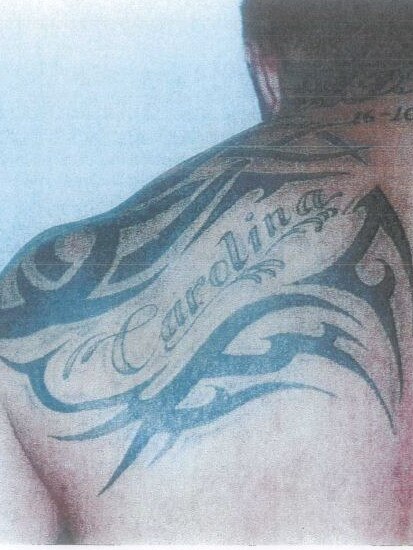Mick Hawi stares down the barrel of the police officer’s camera and removes his shirt, giving a rare glimpse of the tattoos that illustrated his life journey. It is April 6, 2009, and the 28-year-old is being photographed in the bowels of a police station after handing himself in over a savage daylight brawl in the middle of Sydney Airport.
The brawl resulted in the death of a rival bikie gang member and will forever change the way bikies are policed, and airport security is administered, in this city.
The process is part of what is known as a forensic procedure. This stage of it requires the officer to photograph any significant markings on Hawi’s body so it can be kept in the police intelligence database.
In Hawi’s case, there are several.
“Turn around and face the wall,” the officer says.
Snap.



Chapter 1: Tattoos that told the life story of Mick Hawi
Chapter 2: Comanchero boss Hawi a rare one-woman bikie
Chapter 3: Bikie brawl and airport killing changed Sydney forever
Chapter 4: Depressed Hawi’s world falls apart
Chapter 5: Money troubles before Hawi’s life ends in a hail of bullets
The officer captures the large letters that stretch from hip to hip across the small of Hawi’s back. It says “Comanchero”, a mark of loyalty to the bikie gang Hawi had been the national president of since he was just 22.
“Put your chin to your chest and raise your left shoulder,” the officer says.
It brings into view the curls of ink that forms the name of Hawi’s wife, “Carolina”.
She is the woman Hawi met as a 12-year-old and had been in a fiercely loyal relationship with since he was 15.
The name is within a jagged tribal pattern that runs up to Hawi’s neck and down the front of his left pec and bicep.
A Surry Hills tattoo artist, who asked not to be named, said the art did not appear to have any ethnic connection. Instead, the artist said it was similar to a design made popular in the late 1990s after it was adorned on the body of George Clooney’s character in the 1996 vampire film, From Dusk till Dawn.
“Those tattoos became very popular after that movie came out,” the artist said. “Everyone was getting them.”
Above that, at the base of Hawi’s neck, is his son’s name which sits above another part of the tattoo that documents the younger Hawi’s birthdate in 2003.
The officer continues: “Turn around, face to your left and lift your right shoulder.”
There on Hawi’s right bicep is the cedar tree of Lebanon, where he was born on June 29, 1980.



The tree has been drawn over the top of a sword and a tower that is topped with the Turkish crescent moon and star. The tattoo bears the hallmarks of being done when Hawi was a younger man.
It has faded and was likely inked onto Hawi’s arm when he was a thinner version of himself.
At 28 years old, Hawi’s hulking bicep has grown a lot since then and the tattoo sits off centre from where it was likely drawn all those years ago.
Curling up Hawi’s left hip is an Asian dragon, a symbol of power and royalty.
Hawi’s facial expression for the camera tells as much of a story as his tattoos.
It is a perfect performance for a high ranking bikie, given his current circumstance.
Hawi looks straight down the camera barrel with restrained menace and performs a perfectly formed ‘What the f..k are you looking at?’ face.
After ten years in his line of work, it is most likely his resting face.
THE EARLY YEARS: FROM WAR-TORN BEIRUT TO HUSTVILLE BOYS HIGH
The Mick Hawi story began in Lebanon on June 29, 1980.
On that date he became the second child born to parents Ahmad and Nahda Hawi.
On business records, Hawi listed his birth place as the capital Beirut.
His father listed three locations as his birth place. Beirut as well as the historically significant city of Baalbek and the farming area known as Bekaa.
The family was poor but happy. And soon after three more children would be added, taking the family tally to three daughters and two sons.
Poverty solidified the family.
GALLERY:
In his report tendered to court, forensic Psychologist Timothy Watson-Munro said that during their consulting sessions Hawi “describes a close and well bonded family relationship.”
But war torn Lebanon in the 1980s was no place to raise a family.
In his reference tendered to Hawi’s murder appeal, a family friend said the family relocated to Sydney in 1985 with almost nothing except some family connections.
“They had it tough,” wrote the friend who met Hawi when they were both five and would remain close enough to put up $200,000 in bail to secure Hawi’s release from prison while he awaited trial over the Sydney Airport killing of a Hells Angels bikie.
“The family of five shared one room at their (aunt’s) house, but despite that they stayed close and resilient,” the friend wrote.
The family’s financial position meant private schools were not an option for Hawi.
He attended Bexley Primary School until he completed year six.
Hawi’s first year of high school was at the nearby Hurstville Boys High where he would only spend year seven before moving on.
The school was where he first met Carolina Gonzales, who was in year eight at the time and attended Bethany College, the all girls school across the road from Hurstville Boys High.
When his parents moved from Rockdale to Legarno, Hawi transferred to James Cook Boys Technology High School in Kogarah for years eight and nine. He returned to Hurstville Boys High for year 10, which was his final year of high school.
At 16 and with a school certificate to his name, Hawi became an apprentice spray painter.
He trained at TAFE for two years but didn’t finish the final two years, figuring he had the required skills, Dr Watson Munro’s report said.

Hawi’s first job, the report said, was at his father’s spray painting business in Bankstown where he worked for two years before it was sold.
His next venture was a car detailing business, the report said, which Hawi bought and operated for three years.
ASIC documents have no record of either business.
However, records do exist of Hawi’s next venture where he would employ his father.
At 24 Hawi established Aust Chill, a two truck operation that ran as a refrigerated goods delivery service.
This time it would be Hawi who employed his father as a driver.
The next year, when he was 18, an opportunity presented itself that would later prove to be the defining fork in the road moment in Hawi’s life.

